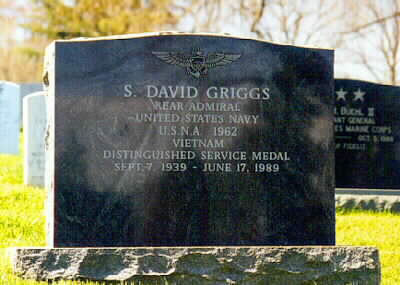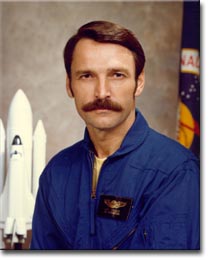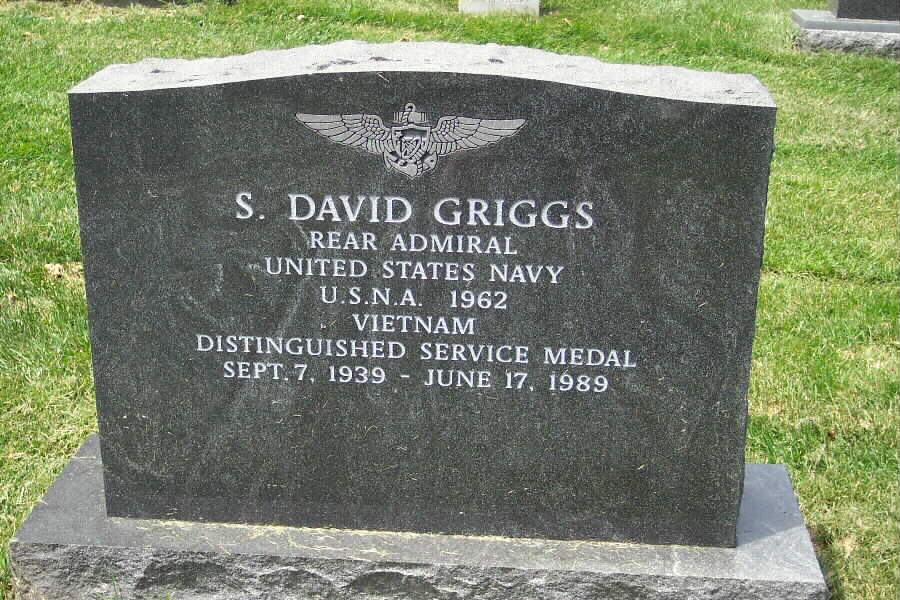Nationality American
Born September 7, 1939
Portland, Oregon
Died June 17, 1989
Earle, Arkansas
Occupation1 Test Pilot
Rank Rear Admiral, USN
Space time 6d 23h 55m
Selection 1978 NASA Group
Mission(s) STS-51-D
Mission insignia
Stanley David Griggs (September 7, 1939-June 17, 1989) was a NASA astronaut credited with conducting the first unscheduled extra-vehicular activity of the space program. He was killed when the vintage World War II training aircraft he was piloting crashed near Earle, Arkansas.
Born in Portland, Oregon, Griggs graduated from Lincoln High School in his hometown in 1957. He is an Eagle Scout. In 1962 he received a Bachelor of Science degree from the United States Naval Academy and in 1970 a Master of Science in administration from George Washington University. He enjoyed flying, auto restoration, running, and skiing. He married Karen Frances Kreeb and they had two daughters together, Alison Marie (August 21, 1971) and Carre Anne (May 14, 1974).
Griggs graduated from Annapolis in 1962 and entered Naval pilot training shortly thereafter. In 1964, he received his United States Navy pilot wings and was attached to Attack Squadron-72 flying A-4 Skyhawks. He completed one Mediterranean cruise and two Southeast Asia combat cruises aboard the aircraft carriers USS Independence and USS Franklin Roosevelt.
In 1967 Griggs entered the U.S. Naval Test Pilot School at Patuxent River, Maryland and upon completion of test pilot training was assigned to the Flying Qualities and Performance Branch, Flight Test Division, where he flew various test projects on fighter and attack-type aircraft. In 1970, he resigned his regular United States Navy commission and affiliated with the Naval Air Reserve in which he achieved the rank of Rear Admiral.
As a Naval Reservist, Rear Admiral Griggs was assigned to several fighter and attack squadrons flying A-4 Skyhawk, A-7 Corsair II and F-8 Crusader aircraft based at Naval Air Stations in New Orleans, Louisiana and Miramar, California. He logged 9,500 hours flying time, 7,800 hours in jet aircraft, and flew over 45 different types of aircraft including single and multi engine prop, turboprop and jet aircraft, helicopters, gliders, hot air balloons and the Space Shuttle. He made over 300 aircraft carrier landings and holds an Airline Transport Pilot License and was a certified flight instructor.
In July 1970, Griggs was employed at the Lyndon B. Johnson Space Center as a research pilot, working on various flight test and research projects in support of NASA programs. In 1974, he was assigned duties as the project pilot for the space shuttle trainer aircraft and participated in the design, development, and testing of those aircraft pending their operational deployment in 1976. He was appointed Chief of the Shuttle Training Aircraft Operations Office in January 1976 with responsibility for the operational use of the shuttle trainer, and held that position until being selected as an astronaut candidate by NASA in January 1978. In August 1979, he completed a 1-year training and evaluation period and became eligible for Space Shuttle flight crew assignment.
From 1979 to 1983 Griggs was involved in several Space Shuttle engineering capacities including the development and testing of the Head-Up Display (HUD) approach and landing avionics system, development of the Manned Maneuvering Unit (MMU), and the requirements definition and verification of on-orbit rendezvous and entry flight phase software and procedures. In September 1983 he began crew training as a mission specialist for flight STS-51-D, which flew April 12-19, 1985. During the flight, Mr. Griggs conducted the first unscheduled extravehicular activity (space walk) of the space program. The space walk lasted for over three hours during which preparations for a satellite rescue attempt were completed.
At the time of his death, Mr. Griggs was in flight crew training as pilot for STS-33, a dedicated Department of Defense mission, scheduled for launch in August 1989.
Special honors:
Distinguished Flying Cross
Meritorious Service Medal
15 Air Medals
3 Navy Commendation Medals
Navy Unit Commendation
Meritorious Unit Citation
Defense Distinguished Service Medal
National Defense Service Medal
Republic of Vietnam Campaign Medal
Vietnamese Cross of Gallantry
As well as the NASA Space Flight Medal, NASA Achievement Award, and NASA Sustained Superior Performance Award.
From a contemporary news report:
“S. David Griggs, 49, an astronaut who had ridden on one Space Shuttle mission and was scheduled to pilot another in November, died on June 17, 1989 when the World War II vintage plane he was flying crashed in Arkansas during a weekend air show.
“In 1976, he was appointed Chief of the Shuttle Training Operations Office, where his responsibilities included operational use of the shuttle trainer. He became an astronaut in August 1979 and had been a mission specialist on the Shuttle Discovery in April 1985.
“A Navy veteran, he had flown two combat tours of duty in Southeast Asia and a stint as a test pilot. He was a native of Portland, Oregon, and lived near Houston.”
From another contemporary news report
“Earle, Arkansas – Astronaut S. David Griggs, who flew on the Space Shuttle in 1985 and was training to pilot a mission in November, died yesterday (June 17, 1989) in a plane crash in Eastern Arkansas, authorities said. Lamar Coleman, a dispatcher for the Crittenden County Sheriff’s Office, said the crash happened just after 9 AM south of Earle, which is about twenty miles west of Memphis, Tennessee. “I understand he was doing some stunt-type flying for a private air service based in Earle,” Coleman said.
“An astronaut since 1979, Griggs was training as pilot for a November shuttle flight and had flown as mision specialist on the shuttle in April 1985. NASA spokesman Jeff Carr said a pilot for the November flight will be selected from other available astronauts.”
From another comtemporary news report:”June 18, 1989: Astronaut S. David Griggs died Saturday (June 17, 1989), when he crashed while flying stunts in a single-engine plane near Earle, Arkanas. Griggs, 49, lived in Seabrook, Texas. He was preparing to fly a classified military mission of the Space Shuttle Discovery in November and would have been the co-pilot. Griggs is the fifteenth American to die in space or while a member of the National Aeronautic and Space Administration’s Astronaut Corps. Four others have died in plane crashes. He is the first astronaut killed since five astronauts and two civilians died in the explosion of the Shuttle Challenger on January 28, 1986, although Astronaut-Candidate Stephen D. Thorne, 33, died in a stunt plane crash in Santa Fe, New Mexico, the following May.
“A Naval Reserve Rear Admiral, Griggs was married and had two teenage daughters. He was a native of Portland, Oregon and was a 1962 graduate of the United States Naval Academy. He flew the Navy’s A-4 fighter-bombers from aircraft carriers during the Vietnam War, acording to NASA.
“Griggs was killed instantly in the crash at 9:10 AM near Earle. He was flying alone and performing rolls in a 1940s vintage plane when its wing touched the ground, causing the crash, said Arkansas State Trooper Melton Nix. Griggs was flying for the McNeely Charter Service, a private air service based in Earle. The plane hit the ground in a field of wheat near the company’s hangars. A Federal Aviation Administration investigator told the Associated Press that Griggs was practicing to perform at an airshow in Clarksville, Arkansas. “It occurred while he was off-duty and in a private aircraft. Since it was not a NASA aircraft, we would probably have minimal involvement in whether an investigation isdone,” said Doug Ward, Deputy Director of Public Relations for NASA.
“Griggs made his one and only space flight in April 1985 on the Shuttle Discovery. Receiving more attention was another member of the crew, United States Senator Jake Garn of Utah, whose influence over NASA funding made his request for a Shuttle ride nearly impossible to refuse. But Griggs and Astronaut Jeff Horrman stole the show. They made an unscheduled, three-hour spacewalk 200 miles above the earth to rig a sort of handmade flyswatter on the Shuttle’s mechanical arm. Rhea Seddon then used it to flip a switch on a dead military satellite weighing 15,500 pounds, but the spining satellite refused to come alive. The November mission for which Griggs was training also includes a female crw member, Kathryn C. Thornton, who will be the first woman to make a classified Department of Defense flight aboard a space shuttle.”
His private memorial is in Section 7-A of Arlington, near that of Michael John Smith of the Shuttle Challenger.

Michael Robert Patterson was born in Arlington and is the son of a former officer of the US Army. So it was no wonder that sooner or later his interests drew him to American history and especially to American military history. Many of his articles can be found on renowned portals like the New York Times, Washingtonpost or Wikipedia.
Reviewed by: Michael Howard


